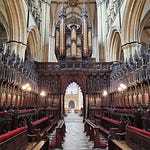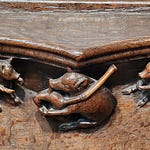I’m going to try something a little different here and provide some extracts from an interesting book on history and legends of churches. For those who like to listen, I’m providing an audio version. Please forgive my oddities of accent and pronunciation!
For those who, like me, prefer written form, here is a transcript.
Lore and Legend of the English Church, published by George S. Tyack in 1899.
Chapter 1, Part 1, The Building of the Church.
The sites of some churches have been, according to legend, miraculously assigned to them. Everyone who is familiar with the North Country knows the story of the foundation of Durham's glorious cathedral.
In the days when Norse pirates were harrying our eastern coasts, the monks of Lindisfarne were compelled to seek refuge on the mainland, and, exhuming the relics of St Cuthbert as their most precious treasure, they carried them with them. For some years they found no permanent resting place, but wandered over Northumbria, halting now here, now there. For some time Chester-le-Street gave them shelter, but the storm that had driven them inland was now felt far beyond the coasts, and they fled again, this time to Ripon.
At last they essayed to make their way back once more to Chester-le-Street, with the hope of being allowed to settle there, and they had journeyed as far as a place called Ward Law, east of the site of Durham, when they were checked by a new and strange difficulty. The bier of St Cuthbert stuck fast, and not all their combined skill and force availed to stir it.
Perceiving that this was the result of no ordinary cause, the little company fasted and prayed for the space of three days, that the divine purpose might be revealed to them and their devotion was rewarded by the revelation that they were to carry their holy burden to Dunholme. But this caused only further perplexity, for no one knew where Dunholme lay or in what direction to seek for it. While they were thus wondering what was to be done, they heard a woman in the distance crying to a neighbour that she had lost her cow, and asking whether she had by chance seen it. The answer was that the cow had strayed to Dunholme, and that there it would be found.
Full of gratitude for the sign, the monks endeavour to follow the woman, and at once the bier moves on without further difficulty, and their unconscious guide leads them to that spot amid the windings of the Weir, which the towers of Durham and the Holy Shrine of St Cuthbert have since made famous.
Durham Cathedral
Such is the story told in the Rites of Durham, and for ages it has been commemorated on the external face of the northwest pinnacle of the Nine Altars Chapel of the Cathedral by the carving of a woman and a cow.
Supernatural intimation was given also of the site for Cartmel Church in Lancashire. A company of monks had journeyed into the country and had selected a certain hill within Cartmel Forest as a suitable spot for a settlement.
They had already marked out the ground which their church was to occupy, when a voice, speaking to them out of illimitable space, said, “Not here, but in a valley between two rivers, whereof the one runs north and the other south.” Much the brethren marvelled where such a spot could be, but, obedient to the command, they left their chosen place and set forth to seek the one appointed.
After a much fruitless search they came upon a wooded valley, in the midst of which was a morass, from which a sluggish stream flowed northward. Wading through this, they found that the marsh was bounded on the further side by a similar stream which wended its way to the south, while midway between them was a small eminence forming an island among the silent, sullen waters.
Here, therefore, they reared their church and dedicated it in the name of St Mary, while on that hilltop where the wondrous voice had spoken to them, they raised a small chapel in honour of St Bernard, whence the spot is still called St Bernard's Mount.
Cartmel Church
Two legends of a far more fearsome kind reach us from Ireland and Scotland respectively.
The first tells how St Patrick was endeavouring to erect a church on a great rock at Cashel, but that every night a bull of terrible size, from whose nostrils fire flashed, charged at his walls and entirely demolished them and the opposition was only ended by Oisin, the disciple of the saint, dropping onto the back of the bull from a tree under which it rushed, and tearing it into two by its horns, in proof of which story the figure of Oisin astride the bull was, so it is said, carved within the church.
Yet more ghastly is the Scottish tale which recounts how St Columba received supernatural information that his walls at Iona could not be prevented from falling as fast as they were built, except by burying a human victim in their foundations, and how Oran, the saint's companion, offered himself, or was chosen by lot, for the purpose. The legend cannot be accepted as historical.
One is not surprised to find that the malice of the evil powers was not vanquished by their defeat, nor appeased by their victory, in the contest concerning the site of a church.
At Rudston, Yorkshire for instance, the devil made a desperate effort to destroy the building, and the evidence remains to this day.
Within the churchyard stands a monolith, some 24 feet in height above the ground, and supposed to reach to an equal depth below, the weight being computed at about 40 tonnes. This, the local legend alleges, was flung at the church by his satanic majesty. But luckily in this, as in other somewhat similar cases, his malice and his might were not equalled by his accuracy as a marksman, and the huge missile fell short by a few yards.
The stone at Rudston
It is suggested that we have here another example of the consecration to Christian usage of a spot held in reverence by the pagans, for a tradition of the supernatural appears to have attached to this stone from remote antiquity, and the name of the village is alleged to mean the famous stone from the Scandinavian.
Legends of this type are more common on the Continent than with us. Throughout northern Germany and Scandinavia, a story similar to the one above is a usual method of explaining the presence of isolated rocks.
But some giant or troll, and not the devil, is the assailant of the church.
















Share this post